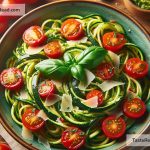The Volumetrics Diet and the Game-Changer in Portion Control
In an era where new diets pop up as fast as morning toasts, the Volumetrics Diet has been making waves for a reason that’s refreshingly different. Unlike diets that make you count every calorie or cut out whole food groups, the Volumetrics Diet zooms in on one thing that plenty of us struggle with – portion control. And it’s not just about eating less; it’s about eating smarter. Let’s dive into how the Volumetrics Diet is reshaping the way we think about food portions and why this could be a game-changer for your health and waistline.
The Basics of the Volumetrics Diet
Created by nutritionist Dr. Barbara Rolls, the Volumetrics Diet is grounded in a simple yet powerful idea: you can eat a larger volume of food, feel full, and still lose weight. How? By focusing on the density of what you eat. Food density refers to the number of calories a food contains relative to its weight or volume. The Volumetrics Diet encourages eating foods that are low in calories but high in volume – think vegetables, fruits, and broth-based soups – so you can eat satisfying portions without overloading on calories.
The Four Categories of Food
To make it easy, the Volumetrics Diet divides food into four categories:
- Category 1: Very low-density foods (non-starchy fruits and vegetables, non-fat milk)
- Category 2: Low-density foods (starchy fruits and veggies, grains, breakfast cereal, low-fat meat)
- Category 3: Medium-density foods (meat, cheese, pizza, French fries)
- Category 4: High-density foods (cookies, chips, nuts, butter, oils)
The goal? Fill your plate with mostly Categories 1 and 2, moderate your intake of Category 3, and limit Category 4.
The Impact on Portion Control
Here’s where the magic happens. Traditional diets often leave people feeling hungry or deprived because they focus solely on reducing portion sizes of all foods, including those that are nutrient-rich and low in calories. The Volumetrics Diet, by contrast, flips the script. It’s not about eating less across the board; it’s about eating more of the foods that nourish you and satisfy your hunger without packing in calories. This shift in perspective is revolutionary for portion control because it focuses on the quality of calories, not just the quantity.
Why It Works
1. It’s filling: High-volume, low-calorie foods are often rich in water and fiber, which help make you feel full. This means you’re likely to eat less overall without feeling like you’re starving.
2. It’s sustainable: Because the diet doesn’t forbid any food groups and doesn’t require you to eat tiny portions, it’s more sustainable than many other diets. You can enjoy a wide range of foods and larger portions of those that are less calorie-dense.
3. It promotes healthier choices: The Volumetrics Diet naturally steers you towards foods that are not only lower in calories but also more nutritious – loaded with vitamins, minerals, and antioxidants.
How to Get Started
Getting started with the Volumetrics Diet doesn’t have to be complex. You can begin by incorporating more fruits and vegetables into your meals, choosing broth-based soups as starters, and opting for whole grains over refined ones. Also, remember to drink plenty of water and stay mindful of the calorie density of foods. It’s not about perfection; it’s about making more mindful choices that add up over time.
The Takeaway
The Volumetrics Diet offers a fresh take on portion control that doesn’t leave you feeling hungry or deprived. It emphasizes the importance of the type of calories you consume, not just the number. By choosing foods that are full of water and fiber, you can eat satisfying portions while still working towards your weight loss goals. It’s a reminder that in the world of nutrition, quality often trumps quantity. In the end, the Volumetrics Diet isn’t just influencing portion control; it’s redefining it in a way that’s both satisfying and sustainable.


